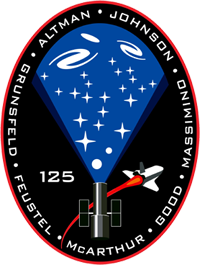Hubble Servicing Mission 4
News: On 28 September 2008, NASA delayed the planned launch of the Space Shuttle Atlantis and its mission to repair Hubble until spring 2009. The launch occurred on 11 May 2009. The reason for the delay was an unexpected failure in the command and data-handling subsystem for Hubble's science instruments. There are back-up channels for each instrument, but technicians need time to assess the status of Hubble and schedule additional repairs. The fifth and final Hubble servicing mission, Shuttle mission STS-125, was originally planned as an 11-day assignment to replace two instruments, hopefully fix two more and replace gyros, batteries and other components crucial for the NASA/ESA Hubble Space Telescope’s continued success through to the year 2014. This mission, named Servicing Mission 4, or SM4 (since SM3 was split in two missions) almost failed to materialise. In the wake of the Columbia Space Shuttle tragedy in 2003, NASA officials decided that astronauts had to be able to reach a safe haven in case any damage caused to a shuttle made a return to Earth too risky. Hubble’s orbit around the Earth makes it impossible for the seven-member crew to take refuge in the International Space Station if the Shuttle is, for instance, damaged during launch. After a re-examination of risks, on 31 October 2006, NASA Administrator Michael Griffin decided, however, that Hubble was such an invaluable tool to astronomers and the public alike that undertaking a last servicing mission was acceptable. A second Shuttle was made ready for launch as a rescue mission during SM4 in order to minimise risks to the astronauts. On launch, Atlantis entered an orbit inclined at 28.5° to the Earth’s equator on a path that intercepted Hubble. Following capture, the mission required five spacewalks, performed by two teams of astronauts operating on alternate days, to carry out all the necessary work.New Instruments: WFC3 & COSThe initial plans for the mission consisted of upgrades to Hubble by installing two new scientific instruments: the Cosmic Origins Spectrograph (COS), replacing the obsolete COSTAR package; and the Wide Field Camera 3 (WFC3), replacing the WFPC2 instrument. Both instruments feature advanced technology that offer a dramatically improved potential for discovery and enable observation of faint light from the youngest stars and galaxies in the Universe. COS primarily studies changes in light emitted from faint and distant quasars that has passed through intergalactic gas clouds. The changes reveal details on the nature of the gas, its evolution, and influence on surrounding galaxies. WFC3 allows Hubble to capture large-scale, detailed images from the near infrared to the far ultraviolet. Fixing Current Instruments: STIS & ACSReplacing instruments is complicated enough, but there was an additional twist with the need to fix two failed instruments: the Advanced Camera for Surveys (ACS) and the Space Telescope Imaging Spectrograph (STIS). The attempt to repair both these instruments was unprecedented as neither was designed to be fixed, or even maintained in space, meaning that engineers had to develop new tools and procedures especially for this mission. Discover more about the unique challenges on the STIS repair and ACS repair pages. SM4 Tasks
By completing these upgrades, Hubble will perform at a level previously unmatched in its already long, celebrated history. For the first time, four instruments will work together to provide both wide and narrow field imaging and spectroscopy from the near infrared through to the far ultraviolet. |
